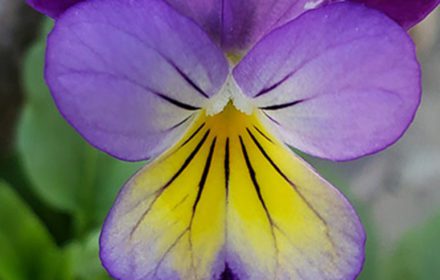How to Grow Silk Purple Cornflower from Seeds
Silk Purple Cornflower (Centaurea cyanus) is a stunning annual known for its soft lavender blooms and long, wiry stems, reaching up to 75 cm. These delicate flowers are perfect for cutting and make a beautiful addition to floral arrangements, providing a charming, rustic look to any room. They are also edible, adding a touch of colour and flavour to salads and drinks. Hardy and easy to grow, cornflowers thrive in full sunlight and well-drained soil, making them a favourite for both experienced and novice gardeners. Follow this guide to successfully sow and grow Silk Purple Cornflower seeds in your garden.
When and Where to Sow Silk Purple Cornflower Seeds
- Indoor Sowing: Start seeds indoors 4-6 weeks before the last expected frost (typically from February to April). This early start allows for a longer blooming period in the garden.
- Outdoor Sowing: Sow seeds directly outdoors from mid-April to May, once the danger of frost has passed and the soil has warmed up. Cornflowers do not like being transplanted due to their taproot, so direct sowing is often the preferred method.
Ideal Growing Conditions for Purple Cornflower Plants
- Soil Requirements: Cornflowers thrive in a variety of soil types but prefer well-drained, moderately fertile soil. If your soil is heavy or clay-based, consider adding sand or organic matter to improve drainage.
- Sunlight: Plant cornflowers in a location that receives full sun for at least 6-8 hours a day. Plenty of sunlight promotes vigorous growth and abundant flowering.
- Temperature: The ideal germination temperature is around 15-18°C (59-64°F). Cornflowers prefer temperate climates and will not perform well in overly hot or humid conditions.
How to Sow Silk Purple Cornflower Seeds Indoors
- Sowing Depth and Containers: Fill seed trays or small pots with a high-quality seed compost. Sow the seeds on the surface and cover them lightly with a thin layer of compost or vermiculite, pressing gently to ensure good contact with the soil.
- Germination Conditions: Place the trays or pots in a bright, warm location with temperatures around 15-18°C. Cornflower seeds need darkness to germinate, so covering them with a light layer of compost is essential. Germination typically takes 7-14 days.
- Watering: Keep the compost evenly moist but not waterlogged. Use a fine mist spray to avoid disturbing the seeds. Once seedlings appear, remove any cover to allow air circulation.
- Transplanting: When seedlings are large enough to handle and have developed a few true leaves, transplant them into individual pots. Harden off by gradually acclimatising them to outdoor conditions for about a week before planting out.
Direct Sowing Silk Purple Cornflower Seeds Outdoors
- Preparing the Soil: Choose a sunny, well-drained spot in your garden. Remove any weeds and rake the soil to a fine tilth. Cornflowers prefer poor to moderately fertile soil, so avoid adding too much fertiliser.
- Sowing Depth and Spacing: Sow the seeds thinly at a depth of 3-6 mm (1/8 to ¼ inch). Space rows about 30 cm (12 inches) apart. Lightly cover the seeds with soil and firm gently.
- Watering and Care: Water the seed bed gently but thoroughly after sowing to settle the soil. Keep the soil consistently moist during the germination period. Once seedlings are 5-8 cm (2-3 inches) tall, thin them out to 20-30 cm (8-12 inches) apart to allow for proper growth and air circulation.
Caring for Silk Purple Cornflower Plants
- Watering: Once established, cornflowers are relatively drought-tolerant. Water regularly during dry spells, but avoid waterlogging the soil. Deep watering encourages strong root growth.
- Feeding: Cornflowers do not require heavy feeding. If necessary, apply a balanced fertiliser once during the growing season to support healthy growth. Too much nitrogen can result in lush foliage with fewer flowers.
- Support: Taller varieties like Silk Purple Cornflower may need support to prevent the stems from bending or breaking, especially in windy conditions. Use garden stakes or plant supports as needed.
- Deadheading: Regularly remove spent blooms to encourage continuous flowering throughout the summer. This also prevents self-seeding if you do not want the plants to spread.
Harvesting and Using Silk Purple Cornflowers
- Cut Flowers: Cornflowers make excellent cut flowers. Harvest them early in the morning when the blooms are fully open. Cut the stems at an angle and place them in water immediately to extend their vase life.
- Edible Flowers: Cornflower petals are edible and can be used as a garnish for salads, desserts, and drinks. Harvest the petals by gently pulling them from the flower head and use fresh or dry for later use.
- Seed Collection: Allow some flowers to go to seed if you wish to collect seeds for the next season. Once the seed heads are dry and brown, cut them and place them in a paper bag. Shake the bag to release the seeds, then store them in a cool, dry place.
Common Questions About Growing Silk Purple Cornflower
- Can I grow cornflowers in containers? Yes, cornflowers can be grown successfully in containers. Choose a pot at least 30 cm deep with good drainage. Use a well-draining potting mix and water regularly.
- Why are my cornflowers not flowering? Lack of flowering can be due to insufficient sunlight, overcrowding, or over-fertilisation. Ensure your plants receive full sun, have enough space, and are not overfed with high-nitrogen fertilisers.
- Do cornflowers attract pollinators? Yes, cornflowers are highly attractive to bees, butterflies, and other beneficial insects, making them a great addition to wildlife-friendly gardens.
By following these guidelines, you can enjoy a vibrant display of Silk Purple Cornflowers in your UK garden. These beautiful, versatile flowers are easy to grow and provide a stunning addition to any garden space, from borders to bouquets.



















